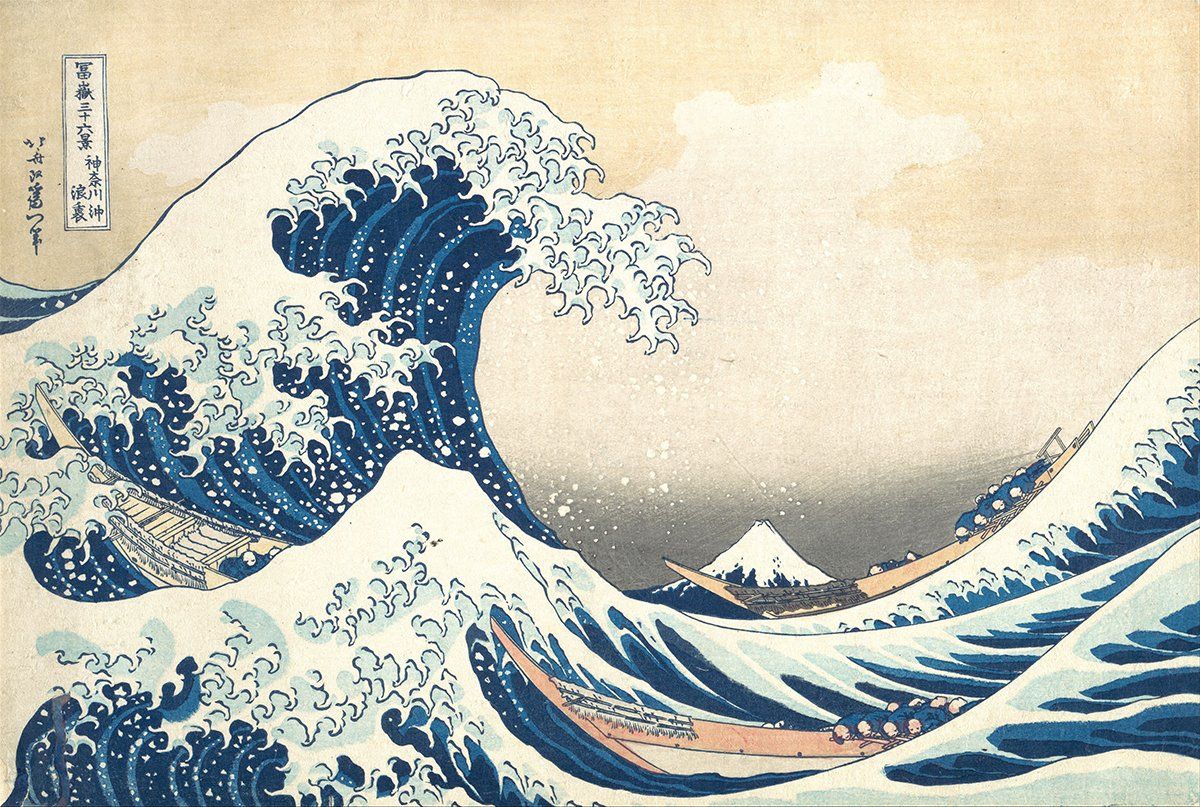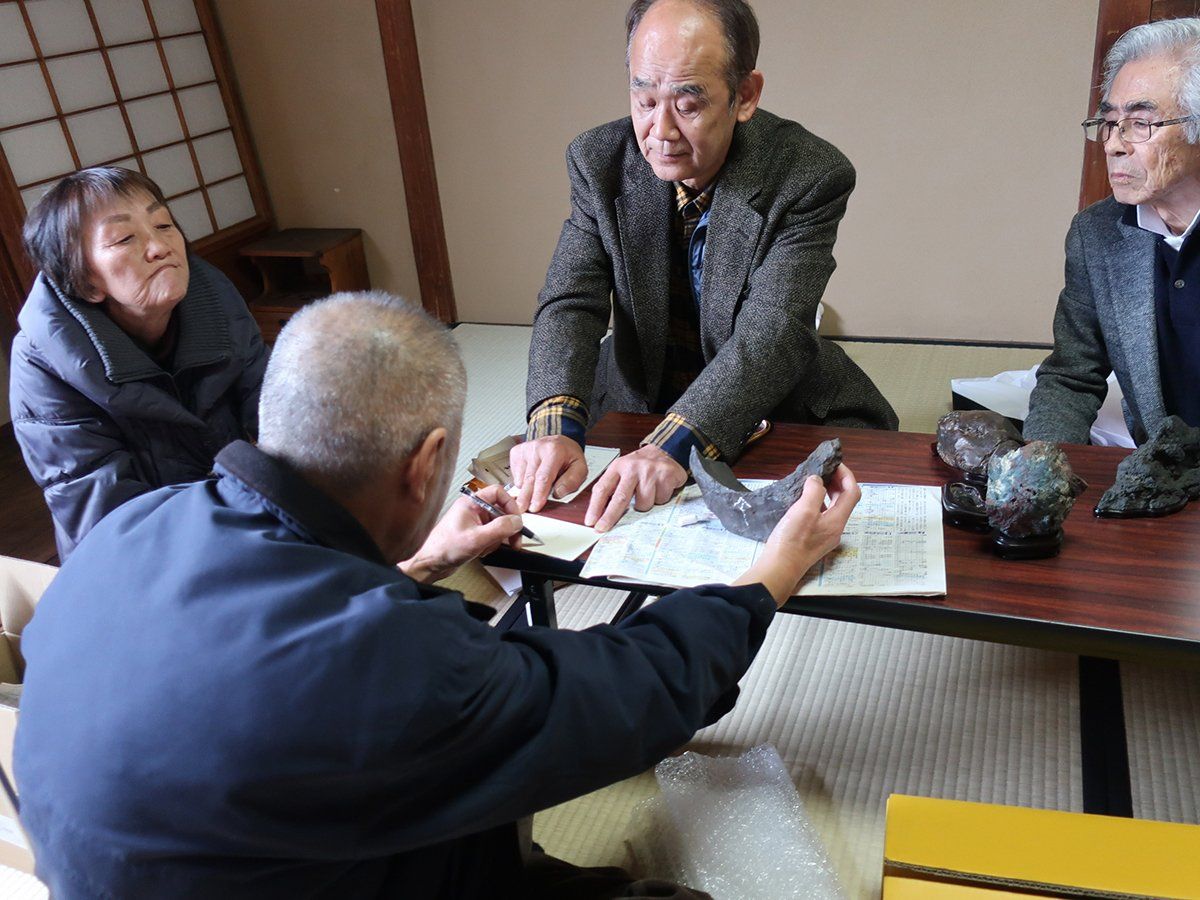Options in Displaying Boat Shape Stones
A discussion of traditional ways of displaying boat-shaped stones while seeking new types of carved wood bases to express the feeling of motion.
By Thomas S. Elias, June, 2021.
Stones that are narrow and resemble a boat are typically displayed in a hand-carved wood base (daiza) or, more commonly, in a ceramic or metal tray (suiban). This article will examine traditional options of display and propose a new approach to create a more dynamic exhibit. The stones used in this article are all from Japan.
Evidence points to the formation of boat-shaped stones by the manner in which certain stone types fracture and cleave along horizontal lines. These pieces are then further shaped by the effects of moving water, sand, and gravel on stones in mountain rivers. This action can result in a rugged appearance that suggests an older weathered boat.
Our mental image of boats depicted in Japanese
suiseki has been influenced by the shape and form of boats in wood block prints from Japan. Most notable among these are the ukiyo-e produced by Hokusai. His print,
“The Hollow of the Deep-sea Wave”
or often abbreviated to “The Great Wave” is perhaps the best known to western audiences. The two boats challenging an enormous wave in this print are part of
Thirty-Six Views Fuji, a series that Hokusai created from 1820 to 1831.
A boat-shaped stone resting on a wood base suggest to me a boat out of the water and in a dry dock situation. This is acceptable because boats have to be repaired at times or removed and stored. For me, this static position is not as appealing as a boat in the water. Thus, it can be difficult to construct suitable wood bases that combine with the stone to make a good display. Here is an example of a successful combination of a
suiseki and
daiza.
Japanese Seta River boat stone, 17 cm wide, 3 cm high and 3.5 cm deep.
Boat shaped stones are typically displayed in shallow ceramic or bronze trays (suiban) with sand, a Japanese display technique that has been adopted by stone collectors in other countries. The size and shape of the tray should be proportionate to the size and shape of the stone. A tray should be large enough to give the impression of openness found in a lake or bay. I prefer a tray that is two to three time the size of the stone to create that impression. An oval tray gives a feeling of more openness than the sharp angles of a rectangular tray. Either tray shape can be used in a display with a stone depending upon the feeling that the exhibitors wish to create.
The shape of the tray can influence the overall feeling of a display.
The sand in the tray with a boat-shaped stone represents water. Japanese tradition dictates that the sand be perfectly level throughout the tray. This can be interpreted that the water is still and the boat is not moving but anchored. Compare the following two displays. The only difference between the two is the location of the stone in the tray. If the stone is placed in the center of the tray, the boat appears more static. If, however, the boat is placed to the right side of the tray with the bow pointed towards the tray’s center, a more dynamic situation is created. Our imagination leads us to believe that the boat is moving towards the center of the tray. This Tama River stone appears to be moving towards the center of the scene. However, the stillness of the water (sand) does not contribute to the dynamics of a moving vessel.
The position of the stone in the tray is important and can suggest the direction of movement.
How does an exhibitor create an impression of a moving boat like the ones being threatened in “The Great Wave?” In July, 2018, I participated in the All Japan Aiseki Exhibition in Sapporo, Japan. I saw a nice boat-shaped stone in the sales area, but the base did not appear to be appropriate for this stone. Despite that, I purchased the stone and brought it to my home where I experimented with displaying in different ways. The light weight base with its narrow delicate legs did not provide a stable foundation for this heavy rugged stone. I found it difficult to display this stone in its original base.
This rugged Tama River stone is 21 cm wide, 10.5 cm high and 8 cm wide and rests in a modern style, light-weight base made of Tilia wood.
I wanted to have a new daiza made for this Tama River stone. A base that would give the impression of a boat moving through a wave, although less dramatic than “The Great Wave” scene. I was inspired by the ukiyo-e works that brought drama and life to everyday life in Japan. I brought this stone back to Japan in February, 2020 to the city of Toyota where a small stone exhibition was being held. Mr. Harda Kazuya, one of the leading daiza carvers in Japan, agreed to come from Nagoya and take the stone so he could make a base for it. My wife, Hiromi and I met with Mr. and Mrs. Harada; Ogawa Seiichi, President of the Chukyo Suiseki Association; Watanabe Kouchi, Advisor to the All Japan Aiseki Association to discuss what type of dazia would be suitable for this stone. I indicated that I wanted the stone and base to have a feeling of a boat moving through water rather than a boat at rest.
We first discussed and agreed upon on the front of the stone and its orientation in a base. Harada marked the stone with white chalk accordingly. Our discussion then turned to the type and style of the base. I gave Harada fairly broad latitude in the final design. The thirty-minute discussion was very informative and give me a better perspective on how experienced Japanese stone connoisseurs look at suiseki. None of the participants were selling stones or related products.
This new rose wood base for the Tama River stone.
The new studier rosewood base (left) is a more substantial base for the stone while providing an artistic representation of water being sliced by a boat and trailing along in the wake.
Harada finished the base several months later and it was kept in Japan so it could be displayed in the Eighth Japan Suiseki Exhibition held at the Tokyo Metropolitan Art Museum in February 14-18, 2021. Mr. Morimae wrote in the exhibition catalog “This is a vivid representation of a boat with a highly curved bow cutting through the waves as it moves forward.” My goal of having a base that expressed the more energetic and imposing force of nature was accomplished. While this deviated from our western concepts of Japanese suiseki practices, I learned from colleagues in the All Japan Aiseki Association that we are not bound by rigid rules and that we should explore ways of expressing feelings.



